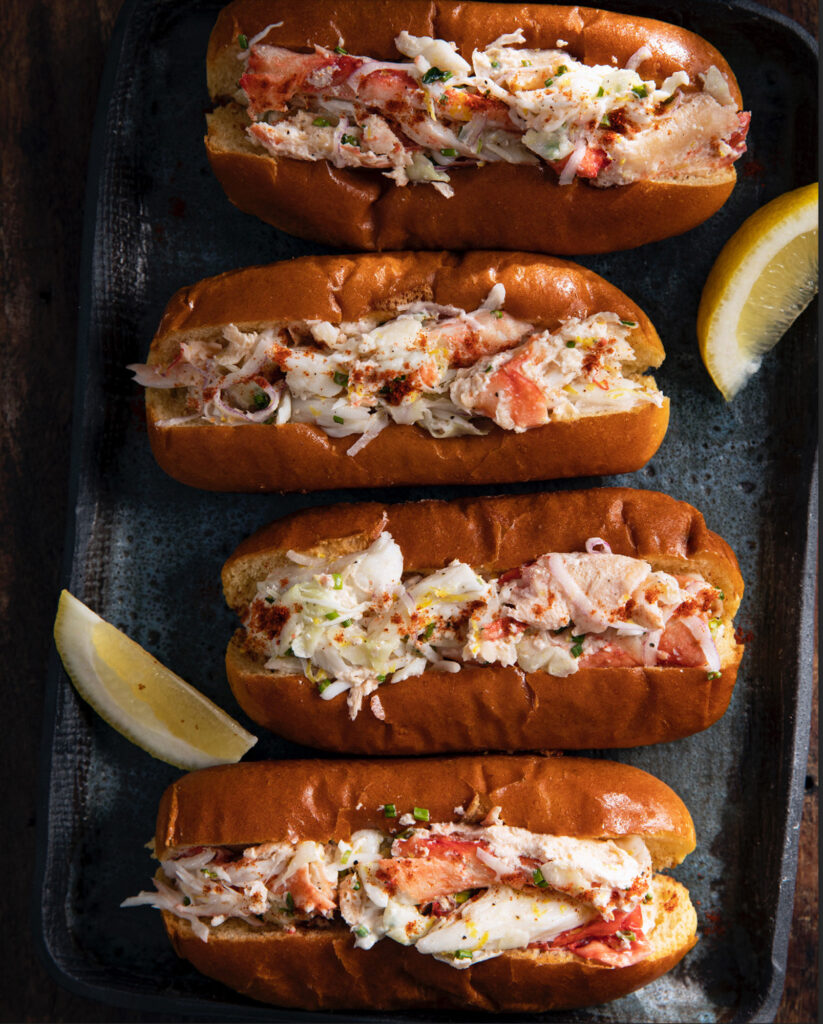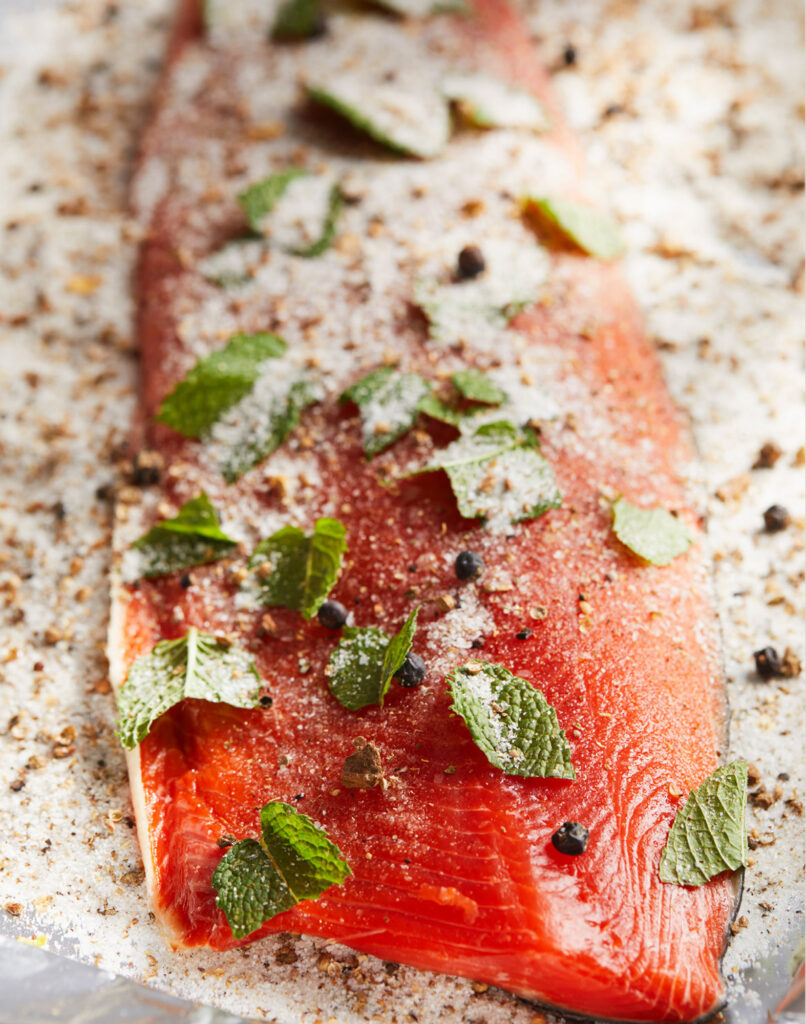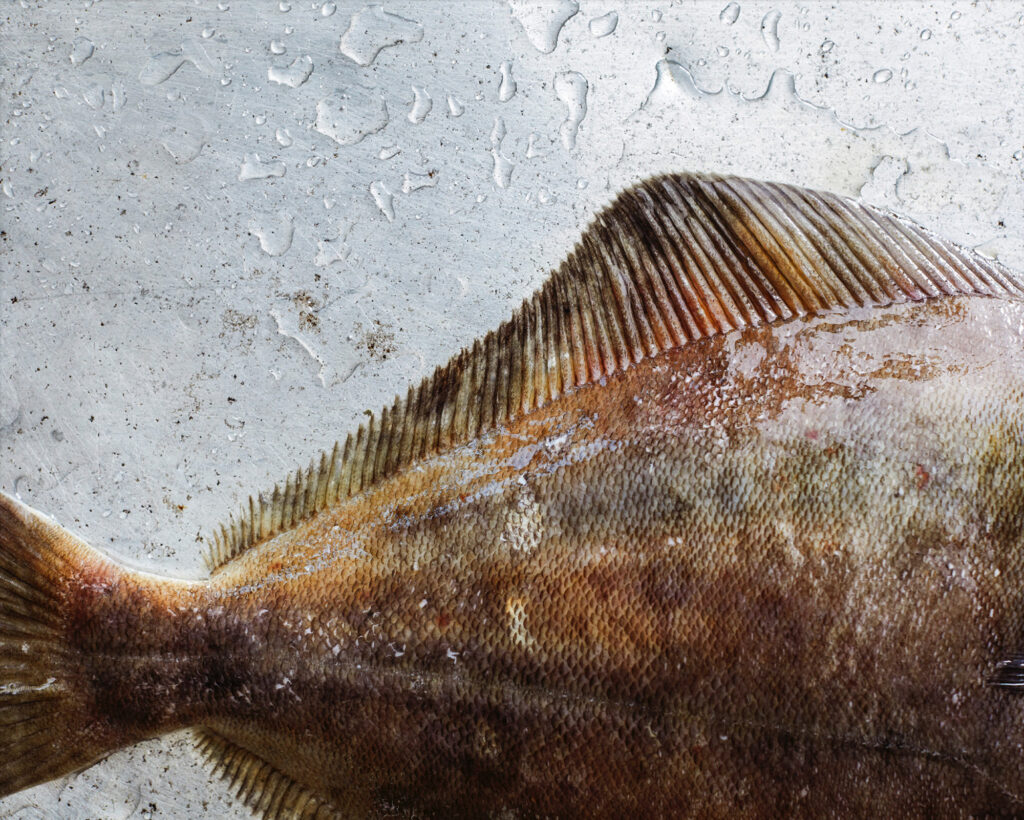By James O. Fraioli
Feature Photography by Charity Burggraaf
For those of us who are fortunate enough to call the Pacific Northwest home, there’s an abundance of diverse marine life found in our bays, estuaries, and seas. And nothing quite compares to our summer fresh sheet: from the king, Chinook and sockeye salmon runs to the fervent Dungeness crab season, plus bounty like our native Olympia oysters, spot prawns, and the almost mythical geoduck. Yes, some of the richest seafood resources on the planet can be found here in our corner.
Recently, I had the good fortune of teaming up with local Chef John Wahlke and Fremont Mischief Distillery on the cookbook: Spirited Cooking from the Pacific Northwest. Whether it’s serving fresh, sustainable fish or aging their select spirits aboard the famed crab boats featured on Discovery’s Deadliest Catch, Fremont Mischief understands seafood and is committed to responsible sourcing, and offers dishes within the pages of this book that showcase just how lucky we are to live in the Evergreen state.

Crab Roll with Smoked Paprika & Fennel Pollen
Inspired by the East Coast lobster roll, this recipe features fresh, succulent Northwest crab. You can use either king crab or Dungeness.
Serves 4 to 6
4 fresh hot dog buns, split
1⁄4 cup whole unsalted butter
2 cups Crab Salad, recipe follows
4 small lemon wedges
1 teaspoon fennel pollen, optional
1 teaspoon smoked paprika, optional
In a sauté́ or cast-iron pan over medium heat, add the butter. When melted, place the bun, cut-side down into the melted butter and toast. Remove from pan and slice an opening into the top of the bun, creating a pocket for the crab. If you like, drizzle some pan butter into the pocket. Next, add the Crab Salad into the roll, making sure to stuff it well without tearing the bun. It is okay to have some crab protruding from the top. Squeeze the lemon wedge on top, and finish with the fennel pollen and smoked paprika, if desired.
Crab Salad
Makes 2 cups
1 pound fresh cooked king or Dungeness crab meat, picked and chilled
1 tablespoon red onion, peeled and thinly sliced and chopped
1 tablespoon thinly sliced and chopped celery
1⁄2 tablespoon thinly sliced chives
1⁄4 cup mayonnaise
2 teaspoons fresh lemon juice
2 teaspoons kosher salt
1⁄2 teaspoon fresh cracked black pepper
1⁄4 teaspoon fennel pollen
1⁄4 teaspoon smoked paprika
In a mixing bowl, add the crab meat. Gently break the meat apart but leave some larger pieces intact. Add the red onion, celery, chives, mayonnaise, lemon juice, salt, pepper, fennel pollen, and smoked paprika. Mix well and reserve in the refrigerator until ready to use.

Gin-Cured Sockeye Salmon
This recipe features gin and its botanicals—a fabulous flavoring for salmon. When shopping, select fresh, wild sockeye salmon. It’s the best salmon for this recipe because of its low-fat content.
Serves 10 (2 ounces per serving)
1⁄2 cup Gin Botanicals, see below
1 cup granulated sugar
1-1⁄2 cups salt
2 pounds fresh sockeye salmon fillet, skin on, pin bones removed
6–10 fresh mint leaves
Gin Botanicals:
3 tablespoons juniper berries
1 tablespoon coriander
1 teaspoon dried lemon zest
1⁄2 cinnamon stick
1 bay leaf
1 teaspoon chamomile
3 cardamom pods, broken
1⁄4 teaspoon fennel
3 black peppercorns
Place all the ingredients for the Gin Botanicals in a blender, grinder, or food processor. Give it a couple of pulses just to crack the spices, but do not grind them. Transfer to a bowl along with the salt and sugar. Mix well to combine.
Next, lay out a sheet of aluminum foil about three times the size of the fillet. Sprinkle half the curing mixture evenly on the wrap. Place the salmon fillet skin-side down on the cure. Add the mint leaves across the fillet, then evenly cover the exposed flesh with a generous amount of the curing mixture. Wrap the fillet in foil and place on a baking sheet and transfer to the refrigerator. Now place a second baking sheet on top of the fillet and hold it down to apply a light weight to the fillet. (A couple soup cans work great for this.) Keep in the refrigerator at least 24 hours.
Remove the salmon from the refrigerator, rinse, and pat dry. Repeat the process (cure, foil, refrigerate for 24 hours) using new foil. You will repeat the process every 24 hours for 3 to 4 days depending on the size and width of your salmon fillet. The goal here is for the flesh to become slightly translucent and firm. The edges may be a bit saltier than the thicker middle part of the fillet. This is normal.
To serve, slice as thin as possible (works well if the fillet is slightly frozen). Store any unused salmon in the refrigerator (wrapped in plastic wrap) for up to 1 week. You can also portion and freeze the salmon in airtight freezer-safe bags for up to 1 month.
Baked Chinook Salmon with Maple Syrup & Spices
In North America, the Chinook or king salmon is one of the most important sport and commercial fish. They’re also the largest salmon species, commonly exceeding thirty pounds. The salmon can be baked with or without the skin. If you prefer to leave the skin on, make sure it has been descaled and thoroughly cleaned and washed beforehand.
Serves 4 to 6
2 tablespoons chili powder
2 tablespoons onion powder
1 tablespoon garlic powder
1 teaspoon ginger powder
1 tablespoon fresh minced thyme
1 lemon, zested
1 medium-sized orange, zested
2 tablespoons smoked paprika
5 tablespoons kosher salt
1 teaspoon white pepper
2 1⁄2 pounds fresh Chinook (king) salmon fillet
3 tablespoons pure maple syrup
Preheat the oven to 350°F.
In a small bowl, add the chili powder, onion powder, garlic powder, ginger powder, thyme, lemon zest, orange zest, smoked paprika, salt, and pepper. Mix well until combined.
Arrange the salmon fillet, skin-side down, on a parchment-lined baking sheet. (Note: You can also use a cedar plank or place on top of herbs and aromatics to introduce more flavor, but that will increase the cooking time.)
Rub the top of the salmon fillet with a thin layer of maple syrup. Then lightly coat the fillet with the spice mixture.
Place the salmon in the preheated oven for approximately 14 minutes. Note: Actual cooking time can depend on the thickness of the fillet, fat content, if you’re using the baking sheet or cedar plank, additional herbs, and your individual oven. If you see any albumin (congealed white protein that oozes out the side of the salmon), that usually means the fish is overcooking or cooking too quickly. Best to keep checking the salmon during the baking process; you can always cook it longer, but there’s not much you can do when it’s overcooked. Additional note: The salmon will continue to cook when removed from the oven, so best to remove it when the middle of the fillet is medium rare. Once removed, serve immediately.

Pickled Halibut
Here’s a sweet and tangy dish that gets better with age. Make a batch and take it camping, enjoy it as an everyday snack, or include it on a summer party tapas tray. Be sure to cut the halibut in large pieces so the fish maintains its cellular structure when pickled. For the pickling method, you can choose to pressure cook to properly can, but due to the delicate flesh of halibut, it’s best to pour the cooled brine over the top of the fish, seal the jars by hand, and refrigerate until ready to serve.
Makes 1 (2-quart) jar
1 quart water
1 cup kosher salt
2 pounds fresh halibut fillet, skinned and cut into 1-inch pieces
Pickling & Spices:
1 cup water
3⁄4 cup distilled white vinegar
3⁄4 cup apple cider vinegar
2 teaspoons yellow mustard seeds
1 tablespoon, plus 1 teaspoon black peppercorns, divided
6 garlic cloves, peeled, divided
3 bay leaves, divided
4 slices peeled fresh ginger
2 fresh thyme sprigs
1⁄2 yellow onion, peeled and thinly sliced
1⁄2 fennel bulb, thinly sliced
1 carrot, peeled and thinly sliced
2 fresh lemon slices
In a small pot over high heat, bring 1 quart of water to a boil. Add the salt, remove the pot from the heat, and allow the salt to completely dissolve. Then place the brine in the refrigerator to cool completely. When cool, add the halibut cubes, cover, and return to the refrigerator for 12 hours. Remove the halibut from the brine and rinse and pat dry the pieces; set aside.
In a saucepot over high heat, add the 1 cup of water, vinegars, mustard seeds, 1 tablespoon of the black peppercorn, 3 garlic cloves, 2 bay leaves, and the ginger. Bring to a boil, then reduce the heat to a simmer and add the halibut. Simmer for 5 minutes, then remove from the heat and refrigerate until cooled completely.
Sterilize 2 glass quart jars (or 4 smaller pint jars). Add the remaining garlic cloves, thyme sprig, and the 1 teaspoon of black peppercorns. Note: Divide evenly if using multiple jars. Carefully remove the halibut from the pickling brine and place in the jar(s), layering with the onions, fennel, carrots, and lemon slices. Finish with the remaining bay leaf. Next, strain the pickling brine to remove any corns or unwanted debris. Pour over the top of the fish until it is fully submerged, and the liquid reaches the top of the jars, almost overflowing. Seal the jars and refrigerate for up to 5 weeks. Serve with crackers, bread, on a salad, or by itself straight out of the jar.
Heirloom Tomato Gazpacho with Sourdough Toast Points & Dungeness Crab
Here’s a chilled raw soup that originated in Spain and ideal for summer gatherings. The most important step is to use the highest quality tomatoes. Unlike commercial tomatoes sold at most supermarkets, in which the tomatoes have had their flavor systemically bred out of them for perfectly round shapes and bright red color, heirlooms—or homegrown garden tomatoes—are packed with wonderful, sweet flavor, and are best for this recipe.
Serves 4 (5 to 6 ounces per serving)
2 pounds multicolored heirloom tomatoes, quartered
1⁄4 cup kosher salt
1⁄4 teaspoon white pepper
1⁄4 cup balsamic vinegar
1/3 cup extra virgin olive oil
1-1⁄2 ounces picked fresh Dungeness crab meat
1 teaspoon fresh chives
1⁄4 lemon, zested
Basil Oil, as needed, recipe follows
Sourdough toast points, as needed
Place the quartered tomatoes in a shallow pan and salt them generously. Cover and place in the refrigerator overnight.
In a kitchen blender, add the tomatoes in four batches and purée on high. Add the pepper, vinegar, and olive oil. Continue to blend until creamy and smooth, about 1 minute. Season to taste with salt. Transfer to a small bowl and add the crab meat, chives, and lemon zest. Drizzle the Basil Oil on top before serving with sourdough toast points.
Basil Oil
3 tablespoons olive oil
2 fresh basil leaves
1⁄4 teaspoon salt
In a kitchen blender, add the oil, basil, and salt and blend well. Pass contents through a coffee filter to strain. Keep the Basil Oil in the refrigerator in an airtight container until ready to use for up to 5 days.
Northwest Chowder
As the first settlers in the Pacific Northwest, local indigenous tribes cooked with an abundance of salmon, clams, oysters, and crabs from the cold waters of the Pacific. This recipe is an attempt to relive those memories. The result is a hearty, creamy soup with tender chunks of potatoes that melt in your mouth. You’ll further enjoy the contrasting flavors of the kale and kelp and the fading brine of the fish and clams.
Serves 4 to 6
1/3 cup whole unsalted butter
1-1⁄2 cups diced yellow onion
1 cup diced celery
1 tablespoon minced garlic
1/3 cup flour
1-1⁄2 cups vegetable stock
1 pint clam juice
1⁄2 cup heavy cream
2 cups whole milk
1 tablespoon kosher salt
2 teaspoons fresh cracked black pepper
1⁄2 cup julienned kale
1⁄4 cup finely chopped bull kelp (or ribbon kelp) blades
1 pound diced Yukon (gold) potatoes
1⁄2 pound fresh wild Pacific rock cod fillets
1/3 pound wild sockeye salmon
3⁄4 pound manilla clams, shucked
2 teaspoons minced fresh thyme
2 teaspoons thinly sliced chives
1⁄2 lemon (about 1 1⁄2 tablespoons), squeezed
1⁄2 teaspoon hot sauce
In a large saucepot over medium-high heat, add the butter. When melted, add the onions and celery. Sweat the vegetables until soft, but do not brown. Add the garlic and stir continuously to not burn the garlic. Add the flour and continue to stir, forming a roux. Reduce the heat to low and continue to thoroughly mix. Add the vegetable stock and clam juice and return the heat to medium-high. Stir to incorporate the roux into the liquid. Add the heavy cream and milk. Bring to a boil, then return to low heat and let simmer while stirring to prevent scorching. At this point, the soup should be thickened. Add the salt, pepper, kale, kelp, and potatoes. Simmer for approximately 15 minutes, stirring often. Add the fish and clams and let simmer for another 10 minutes, or until the fish is cooked through. Add the thyme, chives, lemon juice, and hot sauce. Check the seasoning and add additional salt to taste, if necessary. Note: The chowder is best the next day after the flavors have had a chance to meld. Serve hot with fresh sourdough bread. The chowder will last in the refrigerator for up to 1 week in an airtight container.
Bull Kelp Pickles
Forests of bull kelp thrive along our coastal waters. High in protein, potassium, and trace minerals, bull kelp is beginning to find its way into kitchens. If you have an opportunity to get your hands on some fresh bull kelp, slice the stipe into thin rounds, pickle them per the recipe, and serve them as you would traditional pickles. It’s a nice, crisp alternative to the pickled cucumber.
Makes 3 cups of pickles
3 cups fresh bull kelp stipe, sliced into 1/8-inch rounds
1⁄4 teaspoons red pepper flakes
6 garlic cloves, peeled and crushed
1 teaspoon mustard seeds
1⁄2 teaspoon dill seeds
1 tablespoon coriander seed
2 cups white distilled vinegar
3⁄4 cup water
3 tablespoons kosher salt
1⁄4 cup granulated sugar
Place the sliced kelp rounds into a glass jar. Add the pepper flakes, garlic, mustard seeds, dill seeds, and coriander seeds.
In a small pot over high heat, add the vinegar, water, salt, and sugar. Bring to a boil while stirring occasionally until the ingredients are dissolved. Remove from the heat and pour the hot brine into the jars until the kelp is completely covered. Seal the jars and store in the refrigerator for 3 days. The jars will keep refrigerated up to 4 months.
>> For more stunning summer seafood recipes, be sure to snap up a copy of Spirited Cooking from the Pacific Northwest, available now via: fremontmischief.com. And for more details on SeaFare columnist James O. Fraioli’s upcoming projects, or to get in touch with him about your own cookbook idea, go to: culinarybookcreations.com.